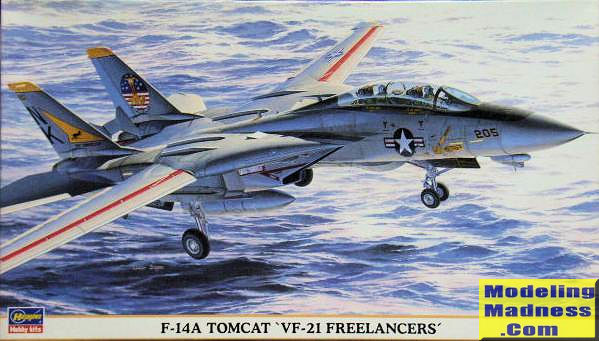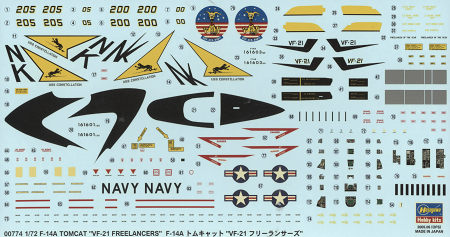
Hasegawa 1/72 F-14A 'VF-21 Freelancers'
| KIT #: | 00774 |
| PRICE: | $20.00 'used' |
| DECALS: | Two options |
| REVIEWER: | Scott Van Aken |
| NOTES: | 2005 Limited reissue |

| HISTORY |
The Grumman F-14 Tomcat is a supersonic, twin-engine, two-seat, variable-sweep wing fighter aircraft. The Tomcat was developed for the United States Navy's Naval Fighter Experimental (VFX) program following the collapse of the F-111B project. The F-14 was the first of the American teen-series fighters, which were designed incorporating the experience of air combat against MiG fighters during the Vietnam War.
The F-14 first flew in December 1970 and made its first deployment in 1974 with the U.S. Navy aboard USS Enterprise (CVN-65), replacing the McDonnell Douglas F-4 Phantom II. The F-14 served as the U.S. Navy's primary maritime air superiority fighter, fleet defense interceptor and tactical aerial reconnaissance platform. In the 1990s, it added the Low Altitude Navigation and Targeting Infrared for Night (LANTIRN) pod system and began performing precision ground-attack missions.[
In the 1980s F-14s were used as land-based interceptors by the Islamic Republic of Iran Air Force during the Iran–Iraq War, where they saw combat against Iraqi warplanes. Iranian F-14s reportedly shot down at least 160 Iraqi aircraft during the war, while only 12 to 16 Tomcats were lost; at least half of these losses were due to accidents.
The Tomcat was retired from the U.S. Navy's active fleet on 22 September 2006, having been supplanted by the Boeing F/A-18E/F Super Hornet. The F-14 remains in service with the Islamic Republic of Iran Air Force, having been exported to Iran in 1976, when the U.S. had amicable diplomatic relations with Iran.
| THE KIT |
As demanded, the panel lines are engraved and the kit offers the ability to have the flaps and slats deployed. In fact, to do it otherwise will require a bit of surgery to be done on the slat tracks. You can also position the glove vanes open or closed. Again, some surgery is needed for the closed position. All F-14s had them wired in the closed position after it was realized that they didn't really do anything and were an additional maintenance hassle. You also have the ability to have the speed brakes and entrance steps/ladder open or closed, and two different tails, though one set is not for this particular boxing. So much has the F-14 been modified and updated over the years that you really need to have photographs of the aircraft that you are modeling to get everything right.
 As required by its price, this kit comes with a small fret of
etched metal. These bits are for the interior, canopy and exhaust. The metalwork
is very well done and should really enhance your Tomcat. For this kit, they
supply the standard F-14A instruction sheet and an addendum sheet that shows the
markings options for this boxing. The instructions are
very well done as you would expect. They offer color callouts based on Gunze
paint as is the norm with Hasegawa over the last decades. Every option and
difference between the aircraft on the decal sheet is given so that you can do a
proper job of things.
As required by its price, this kit comes with a small fret of
etched metal. These bits are for the interior, canopy and exhaust. The metalwork
is very well done and should really enhance your Tomcat. For this kit, they
supply the standard F-14A instruction sheet and an addendum sheet that shows the
markings options for this boxing. The instructions are
very well done as you would expect. They offer color callouts based on Gunze
paint as is the norm with Hasegawa over the last decades. Every option and
difference between the aircraft on the decal sheet is given so that you can do a
proper job of things.
 For markings, we have
two different sets of markings for the same unit. One is the box art plane with
the special 'Bill the Cat' logo on the inside of the fins. The other has a more
extensive black area on the nose of the plane and bit different outer fin
presentation of the wing code and yellow chevron. Both options are in overall
light gull grey so these will not be difficult to paint. The decals are 'old
school' where the whites are more of an off-white and while the kit is over ten
years old, Hasegawa decals have been known to last for decades and still be
viable. Of course, there are still aftermarket options, but really, why
buy a limited edition if you are not going to use the kit markings. The standard
boxing is always less expensive.
For markings, we have
two different sets of markings for the same unit. One is the box art plane with
the special 'Bill the Cat' logo on the inside of the fins. The other has a more
extensive black area on the nose of the plane and bit different outer fin
presentation of the wing code and yellow chevron. Both options are in overall
light gull grey so these will not be difficult to paint. The decals are 'old
school' where the whites are more of an off-white and while the kit is over ten
years old, Hasegawa decals have been known to last for decades and still be
viable. Of course, there are still aftermarket options, but really, why
buy a limited edition if you are not going to use the kit markings. The standard
boxing is always less expensive.
| CONCLUSIONS |
For many modelers, though a bit fussy to build, it is their choice for an F-14 in this scale. Interestingly, I've never built one of these kits, though I have built a number of the original tooling kit and enjoyed it. These are not difficult to find second hand (though perhaps not this particular boxing) and will make into an excellent reproduction.
| REFERENCES |
http://en.wikipedia.org/wiki/F-14_Tomcat
August 2018
Thanks to me for this one, eh?
If you would like your product reviewed fairly and quickly, please contact the editor or see other details in the Note to Contributors.